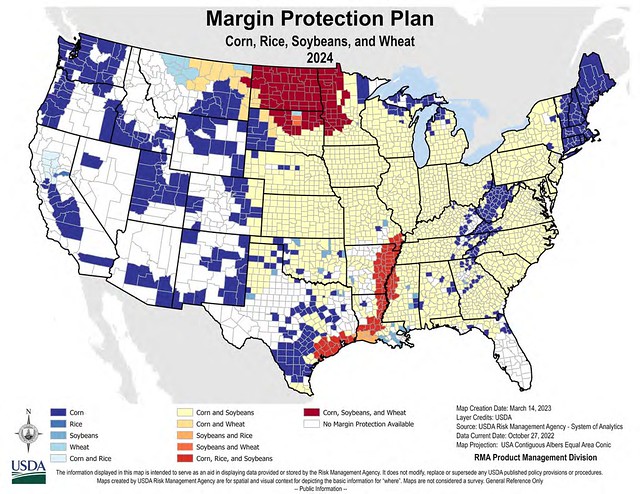Arkansas soybean, corn growers now eligible for Margin Protection insurance
During the winter production meetings, margin protection “was what farmers were asking about." — Hunter Biram
By Mary Hightower
U of A System Division of Agriculture
April 14, 2023
Fast facts
- Margin protection available since 2016
- Enrollment deadline is Sept. 30, 2023
- Extension fact sheet on margin protection available.
(447 words)
(Newsrooms: with maps showing coverage, filer of Biram)
LITTLE ROCK — Arkansas soybean and corn producers are now eligible for Margin Protection insurance under an expansion announced by the Risk Management Agency of the U.S. Department of Agriculture.
RMA’s expansion of the Margin Protection plan will add 1,255 counties for soybeans and 1,729 counties for corn nationwide. This will add coverage in 22 states for soybeans with 34 states being covered in total. It will also make Margin Protection available for corn in the contiguous United States.
“Margin” refers to what’s left when a farmer subtracts the cost of growing a crop from revenue.
The plan is also available in select counties for rice in Arkansas, California, Louisiana, Mississippi, Missouri, and Texas.
Soybean and corn growers have until Sept. 30 to enroll and be eligible for the 2024 crop year. Rice growers will have a sales closing date of Feb. 28 to be eligible.
Even though it’s moot for the current year, “it’s pretty exciting for Arkansas considering that soybeans dominate our acreage in Arkansas,” said Hunter Biram, extension economist for the University of Arkansas System Division of Agriculture.
According to the Prospective Plantings report from the National Agricultural Statistics Service of the USDA, Arkansas soybean growers appear to be planting slightly fewer acres of the crop in 2023, with intended acreage falling 4 percent to just over 3 million acres. Nationally, acreage for the crop remains steady from 2022 at 87.5 million acres.
Arkansas’ corn growers appear optimistic about the crop’s future, increasing acreage 14 percent to 810,000 acres. By comparison, the prediction for all U.S. corn acreage increased by only 4 percent.
Arkansas rice acreage looks to increase by 18 percent over 2022 intentions, to more than 1.3 million acres, accounting for long-, medium- and short-grain varieties. Nationally, growers expect to expand their acreage by 16 percent to nearly 2.6 million acres.
Biram said that during the winter production meetings, margin protection “was what farmers were asking about — ‘What do we do about this? Our margins are so thin right now, and even though we have high prices, we still have high costs to deal with’,” Biram said.
“Increasing the availability of a program is sometimes the best way we can improve upon an effective program and serve our farmers with more risk management resources,” said Marcia Bunger, RMA administrator. “This expansion of Margin Protection will provide a viable insurance option for so many more farmers across the country, giving them greater protection possibilities, and helping us continue our commitment of increasing the availability and effectiveness of Federal crop insurance as a risk management tool.”
Margin protection, first implemented for the 2016 crop year, protects against decreases in margin caused by reduced county yields, reduced commodity prices, increased price of certain inputs or any combination of these issues. It is area-based, using county-level estimates.
The Cooperative Extension Service has a fact sheet on margin protection.
To learn about extension programs in Arkansas, contact your local Cooperative Extension
Service agent or visit www.uaex.uada.edu. Follow us on Twitter and Instagram at @AR_Extension. To learn more about Division
of Agriculture research, visit the Arkansas Agricultural Experiment Station website: https://aaes.uada.edu/. Follow us on Twitter at @ArkAgResearch. To learn more about the Division of Agriculture,
visit https://uada.edu/. Follow us on Twitter at @AgInArk.
About the Division of Agriculture
The University of Arkansas System Division of Agriculture’s mission is to strengthen
agriculture, communities, and families by connecting trusted research to the adoption
of best practices. The Division of Agriculture conducts research and extension work
within the nation’s historic land grant education system through the Agricultural
Experiment Station and the Cooperative Extension Service.
The Division of Agriculture is one of 20 entities within the University of Arkansas
System. It has offices in all 75 counties in Arkansas and faculty on five system campuses.
Pursuant to 7 CFR § 15.3, the University of Arkansas System Division of Agriculture
offers all its Extension and Research programs and services (including employment)
without regard to race, color, sex, national origin, religion, age, disability, marital
or veteran status, genetic information, sexual preference, pregnancy or any other
legally protected status, and is an equal opportunity institution.
# # #
Media contact: Mary Hightower
mhightower@uada.edu
@AgInArk
